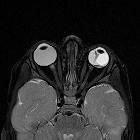vitreous hemorrhage










Vitreous hemorrhage refers to bleeding into the vitreous humor.
Epidemiology
Vitreous hemorrhage has an incidence of approximately 7 in 100000 .
Clinical presentation
The most common clinical presentation is with sudden, painless visual loss to varying degrees of severity . Associated ‘floaters’ or shadows in the vision have also been reported . In traumatic cases, orbital pain may be present, although this is likely to be due to other orbital injuries rather than the vitreous hemorrhage itself .
Slit-lamp examination confirms the diagnosis through visualization of blood in the vitreous chamber, although may have a limited role in detecting the underlying cause if the hemorrhage is diffuse .
Pathology
The vast majority of vitreous hemorrhage occurs secondary to proliferative diabetic retinopathy, posterior vitreous detachment, retinal detachment or tear (which in itself could be due to posterior vitreous detachment or proliferative diabetic retinopathy, among other causes), orbital trauma, or ocular malignancy . However, in a broader sense, bleeding into the vitreous chamber occurs through two main mechanisms:
Radiographic features
Ultrasound
Both A-scan and contact B-scan (more useful) ultrasound have a role in confirming the vitreous hemorrhage and also detecting underlying causes such as posterior vitreous detachment, retinal detachment or tear, trauma, or malignancy .
Findings with B-mode ultrasonography depend on both the severity of the hemorrhage and the time elapsed since the hemorrhage occurred ;
- acute vitreous hemorrhage
- scattered, ill-defined collections of slightly echogenic opacities
- often requires considerable increase in gain to visualize
- demonstrate mobility with extraocular movements
- scattered, ill-defined collections of slightly echogenic opacities
- subacute to chronic vitreous hemorrhage
- organization into more echogenic membranous structures
- when severe may obliterate vitreous body as a confluent, echogenic hematoma
- retains mobility with eye movements
- mobility declines with age of hemorrhage
- organization into more echogenic membranous structures
CT
Hemorrhage usually demonstrates hyperattenuation, which may be either homogeneous or heterogeneous, in the vitreous chamber on CT . Similar to ultrasound, CT can also be utilized to detect underlying orbital pathologies, but has an advantage in also being able to detect extra-orbital pathologies such as subarachnoid hemorrhage (causing Terson syndrome) .
MRI
MRI is uncommonly performed but confirms findings seen on ultrasound and CT. Normally, the vitreous humor demonstrates T1 hypointensity and T2 hyperintensity . These normal signal characteristics are often not appreciated in cases of vitreous hemorrhage . The exact appearance of vitreous hemorrhage on MRI is very variable depending on the age of the blood (see aging blood on MRI), however gradient-recalled echo or susceptibility-weighted imaging are considered the most useful and sensitive sequences where the hemorrhage will demonstrate low signal .
Treatment and prognosis
Although spontaneous regression of the hemorrhage is seen in approximately half of all patients, the condition may require operative intervention with posterior vitrectomy . Treatment of the underlying cause is also paramount .
Differential diagnosis
In some situations consider
Siehe auch:
- Netzhautablösung
- persistierender hyperplastischer primärer Glaskörper (PHPV)
- Aderhautablösung
- Glaskörperblutung bei Subarachnoidalblutung
- intraokulare Silikontamponade
- Glaskörperabhebung
- Zystizerkose des Bulbus oculi
- Retinablutung
- Glaskörper
- nicht traumatische Glaskörperblutung
und weiter:

 Assoziationen und Differentialdiagnosen zu Glaskörperblutung:
Assoziationen und Differentialdiagnosen zu Glaskörperblutung:





